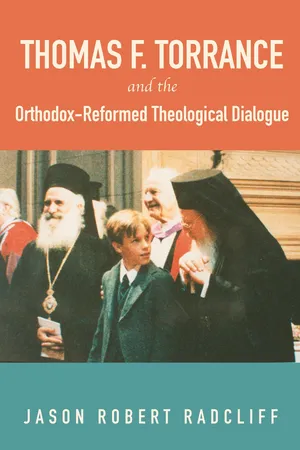![]()
Part 1
A Critical Appreciation of the Orthodox-Reformed Theological Dialogue
![]()
Chapter 1
The Catholic and Patristic Roots of the Orthodox-Reformed Dialogue
A Trinitarian, Christocentric, and Homoousion-Centered Approach
Both the Orthodox and the Reformed readily acknowledged that they have different emphases in their approaches to the doctrine of the Holy Trinity, but they insisted that they agree on the content of the doctrine.
Thomas F. Torrance
Introduction
Colin Gunton states that Thomas F. Torrance offers “a reopening of a major historical conversation and George Dragas elaborates that “few contemporary theologians in [Torrance’s] tradition have so thoroughly and consistently appropriated the spiritual wealth of Greek Patristic Theology . . . ” It was the Reformed, led by Torrance, who approached the Orthodox and initiated the Dialogue. Indeed, Torrance is an important figure in two movements in the latter half of the twentieth century: the ressourcement of the church fathers and the very much connected revival of Trinitarian theology from an ecumenical perspective. A cursory glance at a bibliography of Torrance indicates that he clearly was heavily influenced by the Greek fathers and sees himself as returning to the patristic consensus on, inter alia, the doctrine of the Trinity.
Torrance’s vast work on the doctrine of the Trinity, as seen not least in his books The Christian Doctrine of God and The Trinitarian Faith are, to use the words of George Hunsinger,“studded with Greek patristic citations.” Torrance’s approach to all aspects of his theological scholarship and teaching was undergirded by the church fathers. This approach is perhaps best illustrated by a humorous story oft-told by Fr. George Dragas to his patristics students at Holy Cross. As Fr. George recounts, in his first interaction with his beloved Edinburgh teacher, a bright-eyed Fr. George arrived to Edinburgh to study theology with the famed Professor Tom, who, according to Fr. George, told the University of Basel when they asked him to succeed Karl Barth, that theologians used to come to Basel, now they could come to Edinburgh. Fr. George sat down in his new professor’s New College office and he immediately noticed two pieces of art: an icon of Athanasius and a painting of John Calvin. Fr. George recounts that, upon inquiry, Torrance exhorted the young theologian, “always follow the example of St. Athanasius.” When Fr. George asked about the other figure, Torrance apparently responded, “well, you should read him.” This anecdote, with which Fr. George’s students are familiar, illustrates Torrance’s approach to a theology guided by the Nicene fathers wonderfully. One could look at nearly any one of Torrance’s books to see that the fathers are in the background, if not the foreground of what he is doing. From the connection between Nicene theology and Einstein’s relativity theory in Space, Time, and Incarnation and the realist Nicene theology of the homoousion and the realist philosophy of John Philoponus in Theological Science to the explicitly Nicene Christian Doctrine of God and Trinitarian Faith, the Trinitarian and Christocentric theology of the Greek fathers undergirds all that Torrance does. In his teaching, the connection of Greek patristic and Scottish Reformed theology shines clear not only in his New College lectures recently edited and published by Robert Walker but also in his New College seminars, where, according to the course syllabus, Athanasius’ Letters to Serapion was one of three key texts studied (the other two were Anselm’s Cur Deus Homo and Kierkegaard’s Philosophical Fragments).
Torrance’s patristic study was not, however, done for purely academic or pedagogical reasons. Torrance’s unique “turn to the east” was a part of his greater ecumenical vision which entailed a reunion of churches on the basis of the Trinitarian and Christocentric theology of the Greek Nicene fathers. Torrance practiced this ecumenical theology with Presbyterians, Anglicans, and Roman Catholics from the very beginning of his career as a theologian, professor, and churchman as seen through his published Conflict and Agreement Volumes 1 and 2. Torrance’s early vision of ecumenical rapprochement seemed to be largely reunion on the basis of Greek patristic forms of ministry, sacrament, and episcopacy, but by the 1980s, however, Torrance’s great work with the Eastern Orthodox began as a rather different type of vision of ecumenical rapprochement, namely one of theological agreement. This theological ecumenical work, based on the Greek fathers, is unique and, as George Hunsinger puts it, “[Torrance’s] profound interest in Eastern Orthodoxy—not only in the legacy of the Greek church fathers, but also in face-to-face encounter with Eastern Orthodox theologians . . . may prove crucial to interpreting his entire legacy for present day theology.” It was, indeed, in the Orthodox-Reformed Dialogue that Torrance’s great interest in Greek patristic theology provided the substantial theological and ecumenical ground for a dialogue with the Eastern Orthodox and produced fruit not only for ecumenical theology but also for Trinitarian theology today.
Scope of the Chapter
The Reformed and Orthodox churches interacted in significant ecumenical conversation during the last two decades of the twentieth century; a dialogue spearheaded by Torrance. The Orthodox-Reformed Dialogue took place during the 1980s and 1990s, although more informal dialogue had been going on prior to this between the two traditions. At the Orthodox-Reformed Dialogue, participants gathered, presented papers, and discussed. Torrance published the papers as Theological Dialogue Between Orthodox and Reformed Churches Volume 1 and Theological Dialogue Between Orthodox and Reformed Churches Volume 2 and he wonderfully saved and preserved copies of corre...
